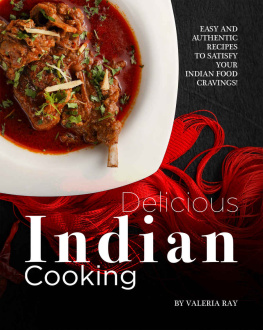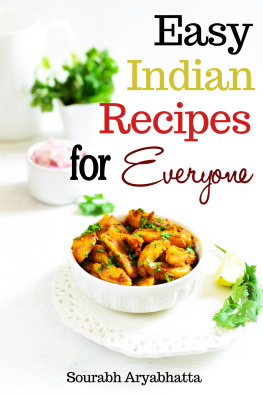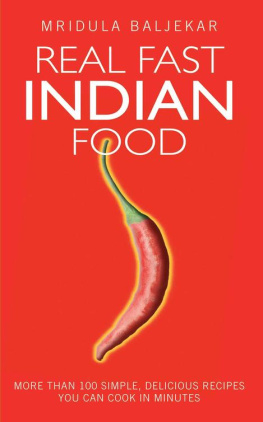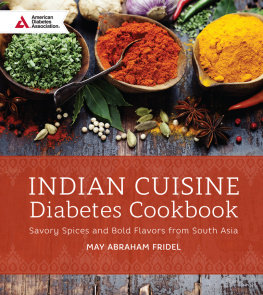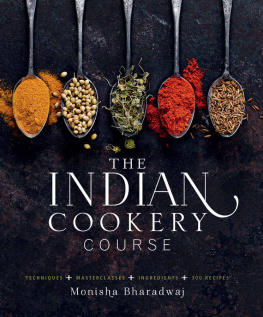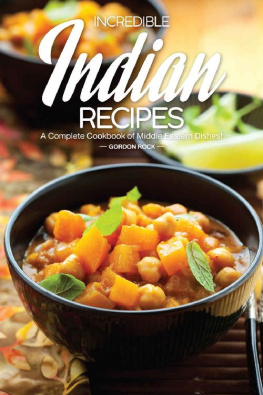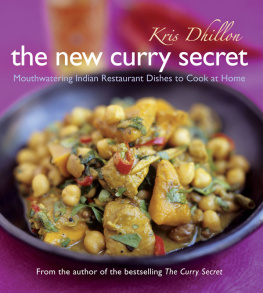Growing up in England, but being born in India, Indian cuisine has always been a part of my life. I was taught cooking by my mother, who was taught by her own mother. I hope Ive also inherited some of her formidable cooking expertise. Within a remarkably short space of time, my mother is able to get two to three main meals ready along with raita, salad, chutney, chapati and a sweet. Just like in my family, Indian recipes are orally passed down through the generations, from mothers to daughters and daughter-in-laws. It is only relatively recently that recipes have been written down.
My mother did not receive written recipes from my grandmother, who was an incredible cook, so I write down recipes from my mother in the hope that one day I can pass these on, not only to my own children but to a wider audience. Needless to say, Im passionate about Indian cookery. However, I also encounter plenty of misconceptions. A common perception of Indian cuisine is that it is mainly comprised of curries and yet curry is not even an Indian word. There is so much more to Indian cooking than what people usually encounter in restaurants and takeaways. However, when I encourage people to try cooking Indian food at home for themselves, I often hear a number of objections and concerns.
The reasons for not cooking Indian are many and varied: It involves too many ingredientsIt is too difficultIt is too complicatedThe food is too hot or spicyPeople dont know where to beginThey dont have the time Yet Indian cooking doesnt have to be any of the above. I have tried to dispel various myths about Indian cooking in this book. By reducing the number of ingredients, my mission is to make Indian food easy and accessible. I want to prove that anyone can create wonderful Indian dishes in their own home in a short amount of time with little fuss. The recipes in this book include many well-known curries, but also simple dishes which can be whipped up in a matter of minutes. There is no real reason to be intimidated by Indian cuisine.
Getting Indian food to taste wonderful is not necessarily about having the exact ingredients and following a strict recipe. It is more about adding spices to fresh ingredients according to your own individual taste. I hope to encourage you to experiment, as Indian cuisine is best approached in the spirit of improvisation. You will have probably noticed that if you have tasted a particular dish in one Indian establishment and order the same dish in another, the meal will not taste exactly the same. Often, even if you go back to the same place, it will taste slightly different. This is because Indian cooks do not generally use measures but make estimates.
Cooks at home will add ingredients according to what is available to them. I want to encourage you to adopt this relaxed and creative approach too. At the core of my approach is simplicity. Our busy contemporary lifestyles often involve balancing the demands of careers with family, and so little time is left for cooking. I have created recipes which are easy and can be prepared quickly, without compromising on taste. These recipes were put to the ultimate test by my daughter and son when they left home for university.
They were always calling and asking for Indian recipes. Being on a budget and not having much time, they were looking for easy recipes that they could make quickly. They invariably went down a treat. The idea for this book came about when I was on a visit to Australia. I was often asked for Indian recipes by my Australian friends, especially Maurice Forde, Helen Watson and Derek Watson. When I served them my dishes, I often received comments such as Gosh, it must have taken all day.
In fact the reality of most of the dishes was that they were prepared quickly. We enjoyed many barbeques, lunches, picnics and dinners that were put together in a matter of minutes. With the encouragement and help of Helen Watson, we soon pulled together my recipes in order to create this book. Helen Watson has been instrumental in the making of this collection; both in helping me collate and test the recipes. Her hard work and support has been the most special ingredient Ive used in creating this book. We both hope that you too will enjoy the recipes.
Try them and see for yourself, we know that you will not be disappointed. India is predominantly vegetarian due to religious and cultural beliefs, but meat is eaten by many and this is normally based on family or personal preferences. Beef is banned in India and only available in the state of Goa. The Hindu religion prohibits its followers from eating beef and the cow is regarded as scared because it ploughs our fields, to harvest food and provides us with milk. Goa has a large community of Catholics and Christians. In fact, the type of foods eaten is closely allied to religious practice in India.
For example, the Muslim population do not eat pork, not only in India but around the world. To add to this complex picture, the different regions in India have their own unique dishes and use of spices. What is important to note is that each region will use locally-sourced fresh ingredients and add spice to make their own unique style of dish. For example, the Punjab region is known for its agricultural production of dairy and wheat. Therefore dishes such as paneer and saag originate from there. Fish is widely available near the coastal regions of India; therefore fish dishes are popular there.
Moreover, Indian cuisine is far from a static body of knowledge. Indian cookery dates back many centuries and has evolved over time, thanks to the many influences brought by invasions and conquests. One of the most important influences was the Mogul rule, which had a major influence on Indian food and the style of cooking. The Moguls were renowned for their big banquets with rich foods and this is where recipes with cream, nuts and dried fruits have evolved. From when the Portuguese arrived in India to trade in spices, they left their own stamp on Indian cuisine, introducing vinegar into meat dishes. The most well-known is vindaloo which is derived from the Portuguese dish Carne de Vinha dAlhos, a dish of meat, usually pork, with wine and garlic from the time the Portuguese were in India.
During the heyday of the British Empire, India was known as The Brightest Jewel in the Crown due to its many natural riches such as diamonds, cotton, wheat and spices. While the British were in India, they adapted many dishes for their own taste, recipes for Worcestershire sauce, mulligatawny soup, and kedgeree to name a few. After India obtained its independence, the British love of Indian food stayed with the people who had lived in India during the time of occupation, but not to the extent that it is today. The first Indian restaurant was opened in England in 1810 by an Indian soldier, who followed his friend to England from the East India company. He was called Sake Dean Mahomed and was born a Muslim in Patna, India, but later on converted to Anglican denomination of Christianity. The restaurant was called the Hindoostane Coffee House and was located at 34 George Street, off Portman Square in London.
The restaurant did not actually serve coffee. However, it was noted to be a place where the nobility and gentry could enjoy Indian dishes of the highest quality. Unfortunately, the restaurant did not do well, and it was forced into bankruptcy in 1812. Dean Mahomed had wanted to appeal to the British people who had returned from India. However, people generally did not go out to eat in restaurants as they had chefs at home to cook for them. The premises are now a building called Carlton House.
Indian restaurants have come a long way from the days of the Hindoostane Coffee House. Today, they have proliferated into every corner of the United Kingdom. Several years ago, chicken tikka masala replaced fish and chips as Britains favourite national dish. 
Next page

